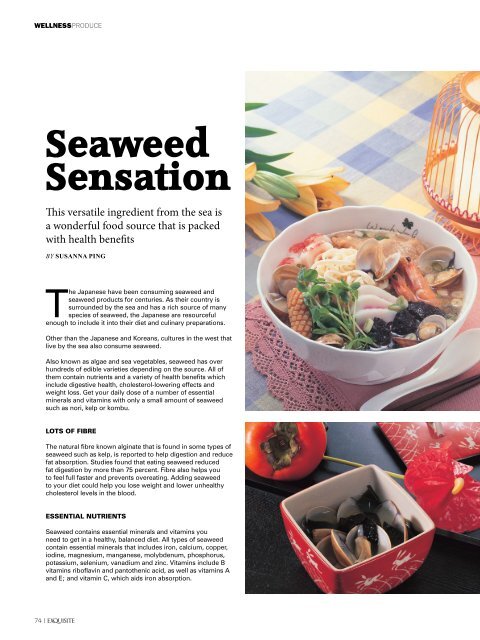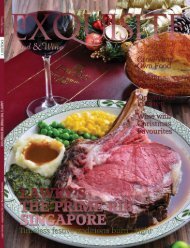ExqMagJul18
Create successful ePaper yourself
Turn your PDF publications into a flip-book with our unique Google optimized e-Paper software.
WELLNESSproduce<br />
Seaweed<br />
Sensation<br />
This versatile ingredient from the sea is<br />
a wonderful food source that is packed<br />
with health benefits<br />
By Susanna Ping<br />
The Japanese have been consuming seaweed and<br />
seaweed products for centuries. As their country is<br />
surrounded by the sea and has a rich source of many<br />
species of seaweed, the Japanese are resourceful<br />
enough to include it into their diet and culinary preparations.<br />
Other than the Japanese and Koreans, cultures in the west that<br />
live by the sea also consume seaweed.<br />
Also known as algae and sea vegetables, seaweed has over<br />
hundreds of edible varieties depending on the source. All of<br />
them contain nutrients and a variety of health benefits which<br />
include digestive health, cholesterol-lowering effects and<br />
weight loss. Get your daily dose of a number of essential<br />
minerals and vitamins with only a small amount of seaweed<br />
such as nori, kelp or kombu.<br />
Lots of fibre<br />
The natural fibre known alginate that is found in some types of<br />
seaweed such as kelp, is reported to help digestion and reduce<br />
fat absorption. Studies found that eating seaweed reduced<br />
fat digestion by more than 75 percent. Fibre also helps you<br />
to feel full faster and prevents overeating. Adding seaweed<br />
to your diet could help you lose weight and lower unhealthy<br />
cholesterol levels in the blood.<br />
Essential nutrients<br />
Seaweed contains essential minerals and vitamins you<br />
need to get in a healthy, balanced diet. All types of seaweed<br />
contain essential minerals that includes iron, calcium, copper,<br />
iodine, magnesium, manganese, molybdenum, phosphorus,<br />
potassium, selenium, vanadium and zinc. Vitamins include B<br />
vitamins riboflavin and pantothenic acid, as well as vitamins A<br />
and E; and vitamin C, which aids iron absorption.<br />
One serving of seaweed contains almost one-fifth of the daily<br />
recommended value of vitamin K. Research shows only a<br />
gram of seaweed provides your daily dose of iodine, a mineral<br />
that is critical for healthy thyroid function. Additionally, a<br />
type of brown seaweed called kombu contains the pigment<br />
fucoxanthin, which reportedly helps metabolise fats for energy.<br />
A serving of seaweed is loaded with more calcium than<br />
broccoli and is almost as rich in proteins as legumes. Other<br />
nutrients in seaweed include vitamin B12 and vitamin A.<br />
Types of edible seaweed<br />
Dried, fresh or preserved, there are many types of seaweed<br />
that can be eaten. Seaweed is also classified as algae, with<br />
more than 20 edible types classified by colour - green, red or<br />
brown. Each variety is unique in its appearance, flavour and<br />
texture. Japan is the leading producer of seaweed and many of<br />
the varieties are known by their Japanese names:<br />
Nori - green purple in colour, this seaweed is best known as<br />
wraps for sushi. Also popular are dried nori snacks.<br />
Kelp - most widely used, kelp comes in a number of edible<br />
types. These include: kombu, the green brown thick sheet that<br />
flavours soups and broths. Arame is a typr of kelp in brown<br />
strands with a sweetish flavour. It can be used in soups and<br />
salads.<br />
Wakame - a brown seweed that looks like fern, it grown in<br />
rocky shores in temperate zones of Japan, Korea and China<br />
Sea caviar - there are many species of Caulerpa lentillifera or<br />
sea caviar or sea grapes. They look like bunches of tiny grapes<br />
and are used mainly for fresh salads.<br />
Dulse - a pink red seaweed that has a tender, chewy texture<br />
Recipes<br />
Japanese seaweed salad<br />
Serves 4<br />
2 cups mixed dry seaweed<br />
1 tbs rice vinegar<br />
1 tbs sesame oil<br />
1 tbs light soy sauce<br />
1 teasp sugar<br />
1/2 teasp sesame seeds (optional)<br />
Salt to taste<br />
Soak the dried seaweed in water for 5 minutes to soften. Mix<br />
the sugar, vinegar, soy sauce, sesame oil and salt in a bowl.<br />
Pour over the seaweed, toss and place on a serving dish.<br />
Scatter sesame seeds on top if using.<br />
Miyeokguk Korean beef and seaweed soup<br />
Serves 4<br />
2 cups dried miyeok seaweed (wakame), soaked<br />
4 cups water<br />
200g beef, sliced<br />
1 tbs garlic, minced<br />
2 tbs fish sauce<br />
1 tbs sesame oil<br />
Salt to taste<br />
Cut the seaweed into strips and add to a large pot with the<br />
water. Boil for about 20 minutes. Add the beef and garlic and<br />
boil for a further 20 minutes. Add the seasonings, mix well and<br />
serve with rice.<br />
74 | EXQUISITE<br />
EXQUISITE | 75
















